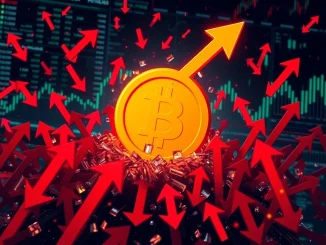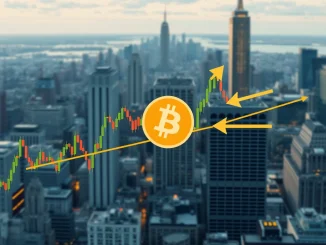
Are you watching the latest shifts in the Bitcoin market? On-chain metrics provide crucial insights, and the Bitcoin RHODL Ratio is one indicator currently grabbing attention. It suggests a notable increase in activity among shorter-term holders, a key dynamic in understanding current crypto market trends.
Understanding the Bitcoin RHODL Ratio
The Bitcoin RHODL Ratio, short for Realized HODL Ratio, is an on-chain metric that helps analysts understand the behavior of different groups of Bitcoin holders. It works by comparing the market value of Bitcoin held by different age groups of coins.
Specifically, the version highlighted by on-chain analytics firm Glassnode compares the realized cap of coins held between 6 months and 2 years against the realized cap of very young coins, typically those held for just 1 day to 3 months. Here’s a simplified breakdown:
- Young Coins (1 day – 3 months): These represent recent purchases or coins that have moved recently. High activity in this group suggests new money entering, short-term trading, or distribution from older holders.
- Mid-Term Coins (6 months – 2 years): These holders have held through a significant period but aren’t the longest-term investors. Their behavior can indicate conviction or potential mid-cycle distribution.
- The Ratio: The ratio of the value held by these groups provides context. A high ratio historically indicated potential market tops, as older coins were valued much higher relative to young ones, suggesting distribution by long-term holders. A lower ratio suggests younger coins are becoming relatively more significant.
What the Recent Peak Below 2 Signifies
Recent Bitcoin on-chain data from Glassnode shows the RHODL Ratio, specifically comparing the 6m-2y band to the 1d-3m band, has peaked below the value of 2. This is a significant observation.
Historically, major market cycle tops have seen this ratio climb well above 2, often into double digits. This indicated that the value held by long-term holders (represented by the older bands in the ratio) was disproportionately high compared to the value held by new entrants or short-term traders. Such high ratios signaled potential overheating and significant selling pressure from experienced holders.
A peak *below* 2, as seen recently, flips this narrative. It indicates that the relative value of coins held by younger market participants (1d-3m) is increasing compared to those held in the 6m-2y band. This strongly signals a rise in short-term activity within the Bitcoin market.
Interpreting Rising Short-Term Activity and Bitcoin Holder Behavior
The increase in short-term activity, as highlighted by the Bitcoin RHODL Ratio, suggests several possibilities:
- Increased Speculation: More traders are actively buying and selling Bitcoin over shorter timeframes.
- New Entrants: A fresh wave of investors might be entering the market, initially holding coins for shorter periods.
- Heightened Volatility: More short-term trading can often lead to quicker price swings.
However, there’s a crucial counterpoint, also noted by Glassnode: there are currently no signs of a significant exit or large-scale distribution by older holders (those holding coins for periods longer than the 6m-2y band, often considered conviction holders). This aspect of Bitcoin holder behavior provides a vital piece of the puzzle.
What This Means for Bitcoin Market Analysis
Combining the signal from the Bitcoin RHODL Ratio with the behavior of long-term holders offers a nuanced view for Bitcoin market analysis:
- Market Dynamic Shift: The market is seeing increased engagement from short-term participants. This adds liquidity but also potential for rapid sentiment changes.
- Underlying Strength: The lack of significant selling from older, experienced holders suggests they are not viewing current price levels as a cycle peak for major distribution. This could indicate underlying confidence in Bitcoin’s future prospects.
- Not a Typical Top Signal (Yet): The RHODL Ratio’s peak below 2, coupled with long-term holders staying put, differentiates the current market from previous cycle tops where significant long-term holder distribution was a hallmark.
This doesn’t guarantee future price movements, but it provides context on who is active and who is holding firm within the crypto market trends.
Challenges and Looking Ahead
While the Bitcoin RHODL Ratio is a valuable tool, it’s essential to remember:
- No single metric is perfect.
- Market conditions can change rapidly.
- Increased short-term activity can make the market more sensitive to news and sentiment.
Analysts continue to monitor Bitcoin on-chain data closely. Future movements of older coins will be a key factor to watch, alongside other metrics like SOPR (Spent Output Profit Ratio) and MVRV (Market-Value-to-Realized-Value) to get a complete picture of Bitcoin holder behavior and overall market health.
Conclusion: A Market of Contrasts
The recent signal from the Bitcoin RHODL Ratio paints a picture of a market experiencing a rise in short-term activity. This indicates growing engagement from newer or more active traders, adding dynamism to the price action. However, the steadfast behavior of long-term holders, who show no signs of significant selling according to Glassnode, provides a contrasting signal of underlying conviction. This unique combination suggests the current market phase is characterized by increasing speculative interest overlaid upon a foundation of strong belief from experienced participants. Understanding these different facets of Bitcoin holder behavior through Bitcoin on-chain data is crucial for navigating the evolving crypto market trends.



